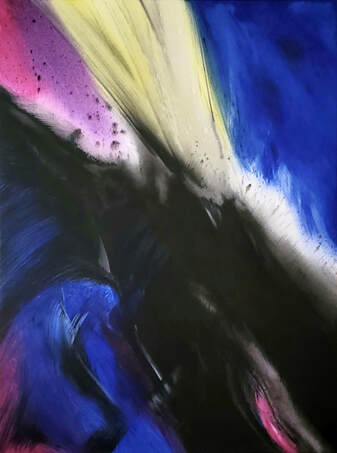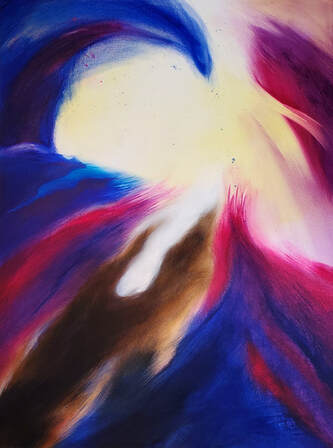Review of Pamela Benham’s exhibition, “With Flying Colors”
Faulkner East and West Galleries, Santa Barbara, October 4-29, 2022
Faulkner East and West Galleries, Santa Barbara, October 4-29, 2022
© Pamela Benham, Untitled SBE 54, acrylic, 48” x 36” © Pamela Benham, Untitled SBE 36, acrylic, 48” x 36”
Expressive Forces in Flight
By Josef Woodard
Pamela Benham’s abstract painting aesthetic tends not to murmur or wallow on the sidelines. Her work is more about bursting into being and seizing the eye of beholders while posing questions not easily answered.
With her latest exhibition at the Faulkner East and West galleries of the Santa Barbara Central Library, dubbed “With Flying Colors,” two of her lively paintings are strategically placed in the central gallery, cleverly tucked in with a concurrent group show. The paintings flank the doorway to her double-gallery domain, appearing as invitational sentries, luring/guiding us through the portal into her personal expressive space, and unique artistic world.
“With Flying Colors” manages to be an ideal title for the artist’s latest show of paintings, produced over the past five years. Like her earlier abstract acrylic-on-canvas paintings, these are vibrantly-hued, spirit abstractions. Colors are clearly empowered protagonists in Benham’s work, both discretely and in conversation and friction with other colors. Colors interweave and melt into each other with a kind of jubilant and only semi-controlled exuberance. Intuition blends with intention in her work.
Extroverted color wrangling aside, the paintings are also informed by intimations of natural forces--sometimes turbulent and possibly volcanic, or active on a cellular level—lending invigorating tensions to the canvases. Colors may be central elements in this work, but so are a primeval sense of action and qualities of metamorphosis, evoking impressions of fissuring, flying, simmering, seeking resolution. Ultimately, it may be said that the seeking is the mission and the destination, an acceptably moving target.
As Benham writes in a statement, her work generally and this body of work specifically aims to “express emotions through color and their design, by the energy of the brushwork, and the dynamics of the light of Hope arriving.” Note the capitalization of “Hope.” Whereas a strong aspect of the historical abstract expressionist genre, in which she is a latter-day participant, comes from a place of catharsis and angst-letting, Benham holds out for hope—or at least the quest thereof--as a fundamental value in her work.
In viewing Benham’s art, precedents spring to mind from past icons of the AbEx genre, including such too-rare female members of the club as Elaine de Kooning, Helen Frankenthaler and Joan Mitchell, as well as Clifford Still—but armed with unabashed color. But Benham has carved out a place for herself and her evolving story as a painter-seeker, having moved through different phases along a path which began a half century ago. She pursued art studies at Cooper Union in New York City and the Ecole des Beaux-Arts in Paris, and worked with Claes Oldenburg while a New Yorker. Stateside, she has exhibited on both coasts, as well as in Europe, but has called Santa Barbara home for more than two decades, showing in various galleries there, as well as in the significant, nationally-known outpost the Museum of Contemporary Art Santa Barbara (sadly, now defunct).
With her latest exhibition, a generous and coherently interactive group of paintings, Benham has organized the works to suggest an almost narrative flow. In each gallery, the show can be “read” left to right, dense-dark to sparse-light.
With Untitled SBL 40, we get an ambiguous suggestion of landscape and a fluid meshing of forms and forces at play. In keeping with her insistence to both explore and let creative energies happen, each painting contains some distinctive features or approaches, while keeping allegiance with her general artistic strategy. In SBL 3, paint drips and splatters change up the typically more sinuous gestural vocabulary, while whorls of visual action energize the view in SBL 40.
Her thickets of brushwork and color embraces yield to spare, airier atmospheres in SBU 5 and SBU 35, the latter notable for its shift of palette, to a pale blue ground (which we read as sky) contrasting contained fiery bursts and purple punctuation marks. But across the room from that relatively tranquil vision, there hangs an opposite impression in the form of SBE 54, with its fierce implosive clenching of black, deep blue and a radiant yellow swipe as a dramatic frozen “moment.”
Satisfying as individual canvases can be on the senses, when viewed as a series, these paintings could be considered as stages in a story, or as gestational stages of an organism or life system’s life and passing—planet Earth, say, or an animal/human life.
At midpoint in the story, on the back wall of the Faulkner East gallery, SBU 12 sets itself slightly apart from the other paintings here. A lightness of being mediates the set of swipes and gestures, with flowering imagery putting us in mind of Georgia O’Keefe’s floral/abstract/vaguely vaginal pictorial language.
With this painting as a prime example, Benham’s range of references can be linked to art historical parallels, but in subtle rather than obvious ways. Her ongoing artistic adventure continues to expand as it settles into itself. Clearly, she has no fear of flying, or of the formidable and transformative powers of color.
(Josef Woodard is an arts journalist and critic, who has written on art for the Los Angeles Times, Artweek, Santa Barbara News-Press and Santa Barbara Independent, and various art catalogue essays. He has also written on music for DownBeat, Rolling Stone, Entertainment Weekly, and other publications, and has two published jazz books and his first novel, Ladies Who Lunch, published in 2021. He is also a musician, who runs the label Household Ink Records.)
With her latest exhibition at the Faulkner East and West galleries of the Santa Barbara Central Library, dubbed “With Flying Colors,” two of her lively paintings are strategically placed in the central gallery, cleverly tucked in with a concurrent group show. The paintings flank the doorway to her double-gallery domain, appearing as invitational sentries, luring/guiding us through the portal into her personal expressive space, and unique artistic world.
“With Flying Colors” manages to be an ideal title for the artist’s latest show of paintings, produced over the past five years. Like her earlier abstract acrylic-on-canvas paintings, these are vibrantly-hued, spirit abstractions. Colors are clearly empowered protagonists in Benham’s work, both discretely and in conversation and friction with other colors. Colors interweave and melt into each other with a kind of jubilant and only semi-controlled exuberance. Intuition blends with intention in her work.
Extroverted color wrangling aside, the paintings are also informed by intimations of natural forces--sometimes turbulent and possibly volcanic, or active on a cellular level—lending invigorating tensions to the canvases. Colors may be central elements in this work, but so are a primeval sense of action and qualities of metamorphosis, evoking impressions of fissuring, flying, simmering, seeking resolution. Ultimately, it may be said that the seeking is the mission and the destination, an acceptably moving target.
As Benham writes in a statement, her work generally and this body of work specifically aims to “express emotions through color and their design, by the energy of the brushwork, and the dynamics of the light of Hope arriving.” Note the capitalization of “Hope.” Whereas a strong aspect of the historical abstract expressionist genre, in which she is a latter-day participant, comes from a place of catharsis and angst-letting, Benham holds out for hope—or at least the quest thereof--as a fundamental value in her work.
In viewing Benham’s art, precedents spring to mind from past icons of the AbEx genre, including such too-rare female members of the club as Elaine de Kooning, Helen Frankenthaler and Joan Mitchell, as well as Clifford Still—but armed with unabashed color. But Benham has carved out a place for herself and her evolving story as a painter-seeker, having moved through different phases along a path which began a half century ago. She pursued art studies at Cooper Union in New York City and the Ecole des Beaux-Arts in Paris, and worked with Claes Oldenburg while a New Yorker. Stateside, she has exhibited on both coasts, as well as in Europe, but has called Santa Barbara home for more than two decades, showing in various galleries there, as well as in the significant, nationally-known outpost the Museum of Contemporary Art Santa Barbara (sadly, now defunct).
With her latest exhibition, a generous and coherently interactive group of paintings, Benham has organized the works to suggest an almost narrative flow. In each gallery, the show can be “read” left to right, dense-dark to sparse-light.
With Untitled SBL 40, we get an ambiguous suggestion of landscape and a fluid meshing of forms and forces at play. In keeping with her insistence to both explore and let creative energies happen, each painting contains some distinctive features or approaches, while keeping allegiance with her general artistic strategy. In SBL 3, paint drips and splatters change up the typically more sinuous gestural vocabulary, while whorls of visual action energize the view in SBL 40.
Her thickets of brushwork and color embraces yield to spare, airier atmospheres in SBU 5 and SBU 35, the latter notable for its shift of palette, to a pale blue ground (which we read as sky) contrasting contained fiery bursts and purple punctuation marks. But across the room from that relatively tranquil vision, there hangs an opposite impression in the form of SBE 54, with its fierce implosive clenching of black, deep blue and a radiant yellow swipe as a dramatic frozen “moment.”
Satisfying as individual canvases can be on the senses, when viewed as a series, these paintings could be considered as stages in a story, or as gestational stages of an organism or life system’s life and passing—planet Earth, say, or an animal/human life.
At midpoint in the story, on the back wall of the Faulkner East gallery, SBU 12 sets itself slightly apart from the other paintings here. A lightness of being mediates the set of swipes and gestures, with flowering imagery putting us in mind of Georgia O’Keefe’s floral/abstract/vaguely vaginal pictorial language.
With this painting as a prime example, Benham’s range of references can be linked to art historical parallels, but in subtle rather than obvious ways. Her ongoing artistic adventure continues to expand as it settles into itself. Clearly, she has no fear of flying, or of the formidable and transformative powers of color.
(Josef Woodard is an arts journalist and critic, who has written on art for the Los Angeles Times, Artweek, Santa Barbara News-Press and Santa Barbara Independent, and various art catalogue essays. He has also written on music for DownBeat, Rolling Stone, Entertainment Weekly, and other publications, and has two published jazz books and his first novel, Ladies Who Lunch, published in 2021. He is also a musician, who runs the label Household Ink Records.)

